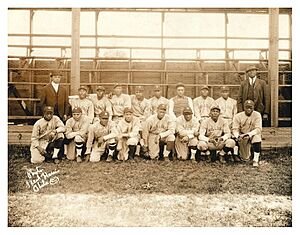Jake Stephens facts for kids
Quick facts for kids Jake Stephens |
|||
|---|---|---|---|
 |
|||
| Shortstop | |||
| Born: February 10, 1900 Springettsbury Township, Pennsylvania |
|||
| Died: February 5, 1981 (aged 80) York, Pennsylvania |
|||
|
|||
| debut | |||
| 1921, for the Hilldale Daisies | |||
| Last appearance | |||
| 1937, for the New York Black Yankees | |||
| Teams | |||
|
|||
| Career highlights and awards | |||
|
|||
Paul Eugene "Country Jake" Stephens (born February 10, 1900 – died February 5, 1981) was a famous American baseball player. He was known for being fast and playing great defense. Jake played as a shortstop in the Negro leagues from 1921 to 1937. He played for four different teams during his career.
Contents
Jake Stephens' Early Baseball Days
Jake Stephens was the younger brother of another Negro league player, Frank Stephens. Jake got his start in professional baseball in a unique way. He sent a telegram to Ed Bolden, who owned the Hilldale Daisies team. Jake pretended to be someone else, telling Bolden about a great young player (who was actually Jake himself!) from York, Pennsylvania.
Bolden was impressed and signed Jake in 1921. Jake hit well in his first year. He then spent part of 1922 playing for both Hilldale and a semi-pro team. In 1923, Jake started to play more often. He filled in for star players like John Henry Lloyd at shortstop and Judy Johnson at third base.
Playing in the Eastern Colored League
In 1924, Jake Stephens was a reserve shortstop for the Hilldale Daisies. He played in the first-ever Negro World Series that year. During Game 8 of the series, Jake felt too nervous to play and asked to be taken out.
After Jake left the game, his teammate Biz Mackey moved to third base. Unfortunately, Mackey made a big error that cost Hilldale the game. The Kansas City Monarchs won that first Negro World Series.
In 1925, the Hilldale manager, Frank Warfield, made Jake Stephens the full-time shortstop. Jake helped the Daisies win their third championship in a row. They also won the Negro World Series against the Monarchs that year. Jake played good defense, which was very important for the team.
Over the next three seasons, Jake continued to play for the Daisies. In 1928, Hilldale traded Jake to the Homestead Grays. He was traded along with Rev Cannady for two other players. Jake later left the Grays and returned to Hilldale for a short time.
Joining the Homestead Grays and Pittsburgh Crawfords
Jake Stephens played for the Homestead Grays again in 1930 and 1931. The 1931 Grays team was one of the best Negro league teams ever. They won 136 games and lost only 17! Jake played alongside many famous players on this team.
Some of his teammates included Jud Wilson and George Scales. The team also had powerful hitters like Josh Gibson, Chaney White, and Oscar Charleston. Their pitching staff was amazing, with players like Smokey Joe Williams and Double Duty Radcliffe. Jake hit very well in 1930, but his hitting struggled in 1931.
In 1932, Jake joined the Pittsburgh Crawfords. He played with more baseball legends like Josh Gibson and Satchel Paige. Jake was mostly known for his excellent defense. He was very good at making acrobatic plays to turn double plays, even if his hitting average was not always high.
Playing for Philadelphia and New York Teams
In 1934, Jake Stephens joined the Philadelphia Stars. He formed one of the best double play teams in the league with second baseman Dick Seay. After the 1934 season, Cumberland Posey chose Jake for the annual All-Star team. He received this honor again the following season.
Jake spent his last two seasons, 1936 and 1937, with the New York Black Yankees. He decided to retire from baseball after 17 seasons. He turned down an offer to play for the Atlanta Black Crackers.
Jake Stephens' Life After Baseball
After retiring from baseball, Jake Stephens moved back to his hometown of York, Pennsylvania. He ran a taproom for two years. From 1939 to 1955, he worked for the Pennsylvania Bureau of Motor Vehicles. Jake also worked part-time as a deputy sheriff.
Jake Stephens is a member of the sports halls of fame in Pittsburgh and York, Pennsylvania. He passed away in 1981 and is buried in York, Pennsylvania.


